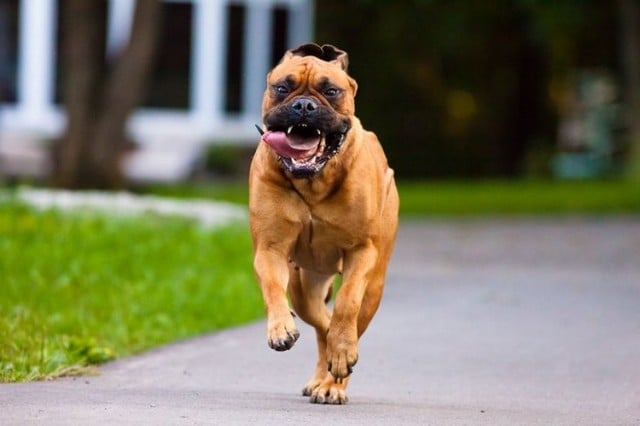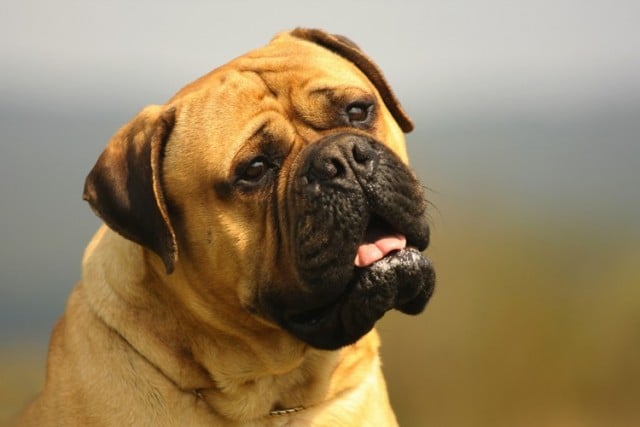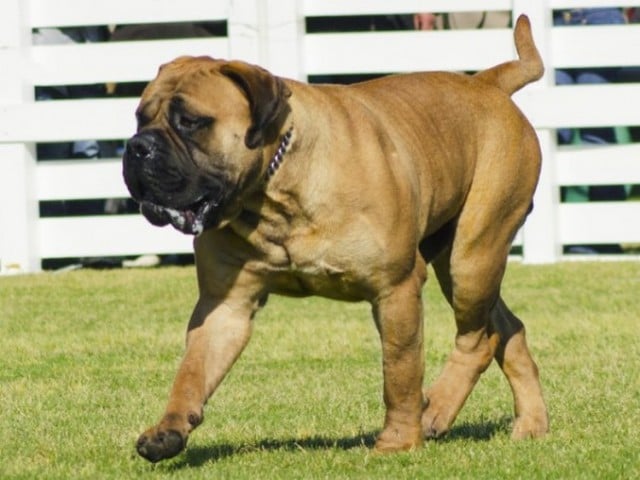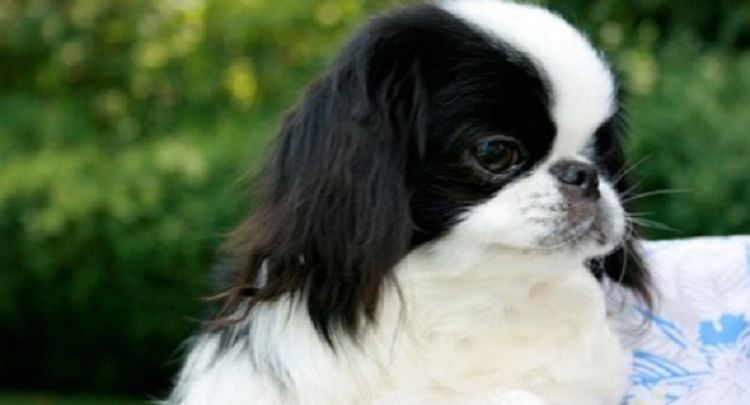What You Need to Know about the Bullmastiff
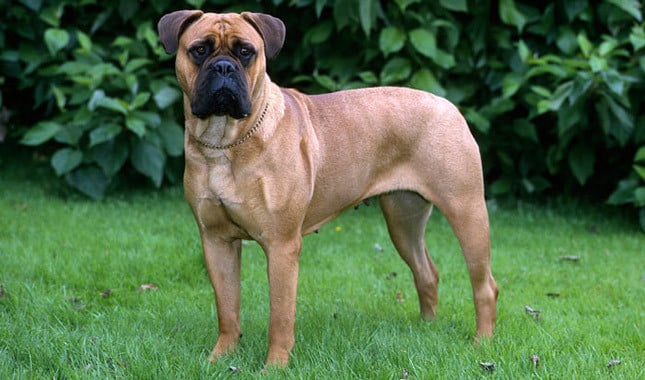
The Bullmastiff is an immensely powerful dog. He is extremely strong and very stocky in the body. This has led to an unfair reputation for fierce behaviour. However, this breed can be exceptionally warm, loyal, and friendly. With a confident and assertive owner, a Bullmastiff is guaranteed to thrive and become an invaluable part of the household.
The breed is easily recognised by its muscular, powerful frame. Yet, it is surprisingly nimble and steady on its feet. It has a large, broad skull, which is wrinkled at the top and a wide, deep muzzle. The forehead is flat and the stop moderate. The Bullmastiff has a black nose and fairly wide nostrils. The teeth meet in a level or undershot bite.
It has medium sized eyes in a dark hazel tone. The V shaped ears are carried high and wide, but close to the cheeks. This gives the head of the dog a square shape. The breed has a high set tail which may be either straight or curved. The back is short, straight, and even between the withers and the loin. The Bullmastiff coat comes in brindle, red, or fawn.
The downside to owning a Bullmastiff is their force of personality. These dogs, though usually mild mannered, can be extremely stubborn. They are fearless, self-assured, and like to get their own way. However, this does make them a very interesting pet. If you are looking for a true companion, rather than a furry distraction, don’t shy away from this wonderful animal.
Origins
The Bullmastiff breed is made up of 60% mastiff and 40% bulldog. It was originally used as a guard dog by English gamekeepers during the 19th century. It was trained to bark on alarm and run down poachers. Crucially though, most gamekeepers taught their dogs only to capture and not to bite. The Bullmastiff is a lot quieter than many other canine breeds, but it can be trained to bark in response to intrusion.
For this reason, Bullmastiffs are still used as guard dogs by many families, but this role now sits alongside their presence as family pets. If trained well, a Bullmastiff can be both deterrent and companion. He is fiercely loyal, very protective, and loves to be around people. If you take on a Bullmastiff from a very young age, you have a responsibility to train it to be able to tell the difference between friend and foe.
Temperament
It is important to understand that even when provoked, or responding to an intruder, most Bullmastiffs are unlikely to bite or attack. They usually chase down, catch, and hold those that they feel pose a danger to their family. So, if you are looking for a guard dog, this breed could be the right choice.
It is friendly towards children, can respond sensibly to strangers, and will shower a devoted owner with affection. Bullmastiffs are surprisingly intelligent, very calm, and crave human leadership. As they have such powerful bodies, it is important for an owner to train them to respect the authority of a leader. Otherwise, they will push and pull during walks and become difficult to control.
The earlier that a Bullmastiff can be socialised and allowed to interact with children, strangers, and other pets, the more friendly they will become. It is important to note that some Bullmastiffs will always be uncomfortable around other male dogs. If this characteristic is present, an owner is advised to limit exposure and keep a close eye on their dog during walks.
While this breed is not the simplest to train, socialise, or control, an assertive owner will reap the rewards. The Bullmastiff is very affectionate and a delight to be around. He should not be left alone too long or too often, because he will begin to exhibit escape behaviours. This dog loves to be around people, so give him lots of attention.
Size and Exercise
The male Bullmastiff is 25-27 inches (64-69cm) tall at the withers. It is 110-130lbs. The female Bullmastiff is 24-26 inches (61-66cm) tall at the withers. She is 90-120lbs. As far as breeding rules go, anything over these measurements is considered poor quality.
This breed needs to be walked at least once a day. It has a keen migration instinct, so if sufficient opportunity to exercise is not provided, it may begin to exhibit escape behaviours. Bullmastiffs that are not properly exercised will become unruly.
Health Issues and Living Conditions
The Bullmastiff is prone to cancer, hip dysplasia, tumours, eyelid dysfunctions, PRA, and boils in the mouth. Problems with bloating are also common, so it is best to feed them little and often, rather than one large meal at the end of the day. The breed gains weight very easily, so you must take care not to overfeed your dog.
The good news is that a Bullmastiff can be kept in a small apartment or flat, as long as sufficient exercise is provided. The breed is fairly passive and inactive indoors, as regards physical activity, so it does not need a lot of space. However, it does struggle with extremes of temperatures.
Life Expectancy
The Bullmastiff has a life expectancy of under ten years. This is not a breed that lives for a long time.
Grooming
This dog has a short haired, slightly rough coat. It is easy to groom and keep clean. Use a frim bristled brush for grooming and only apply shampoo if your pet becomes very dirty. Bullmastiffs shed very little, but their toes need to be trimmed and the health of their feet monitored. As they carry quite a bulky body, they can develop problems.
Caring for Bullmastiff Puppies
Bullmastiff puppies are surprisingly nimble and energetic, even though their bodies are fairly bulky. They often forget to keep more than one foot on the ground! So, they can be a little clumsy and silly at times. This makes them a pleasure to spend time with though.
As aforementioned, they need to be socialised and trained from an early age. The earlier that you can start this the better. Train your Bullmastiff puppy to respect your authority, allow you to lead on walks, distinguish between friend and foe, and behave properly around strangers, visitors, children, and other pets.
As quite a stubborn breed, you may find that the Bullmastiff wears at your patience sometimes. However, consistency is key. Try to avoid shouting or yelling, because this dog is very sensitive to tone of voice. He will respond much better to a calm, even tone and consistent, easy to understand commands.
Keep up with regular veterinary appointments and check-ups, because the breed is prone to tumours and cancer. If these problems occur, the chance of survival will depend entirely on how quickly they are diagnosed and treated.
The Bullmastiff Pitbull Mix
The most high profile Bullmastiff mix is the Bullmastiff Pitbull. However, its reputation is not always a good one. There are many fears about the natural aggression of this breed and its capacity for attack. While Bullmastiff Pitbulls do sometimes bite people, so do many other kinds of dog.
This is an important thing to remember. Every dog has the potential to be a good pet. But they need time, patience, affection, and persistent training and socialisation. If they get all of these things, there is no reason why Bullmastiff Pitbulls (or any other kind of dog) cannot learn to be a calm, responsive, and delightful companion.
In other words, don’t believe the hype. Yes, this dog is extremely powerful, but this does not make it more prone to hostility. If you really want to own a Bullmastiff Pitbull, but you are nervous about raising one correctly, opt for a puppy rather than an adult dog. That way, you can start its training early and make sure that it is comfortable being around strangers from a very young age.
The key to successful training is to introduce the notion of acceptable strangers as soon as possible. Your Bullmastiff puppy needs to be able to distinguish between friend and foe. You want him to serve as a good guard dog, but you also want him to be friendly to guests, visitors, and people at the dog park. It is also a good idea to let your Bullmastiff puppy spend plenty of time around young children.
Other Bullmastiff Mixes
There are a number of other popular Bullmastiff mixes. They include the following:
- Bullmasador (Bullmastiff x Labrador)
- Bullsky (Bullmastiff x Siberian Husky)
- Doubull Mastiff (Mastiff x Bullmastiff)
- Great Bullweiler (Rottweiler x Bullmastiff x Great Dane)
- Mastweiler (Rottweiler x Bullmastiff)Staffordshire Bullmastiff (Bullmastiff x Staffordshire Bull Terrier)
Breed Recognition
The breeding clubs and societies for Bullmastiffs include the associations and groups outlined below. These groups take the welfare of the breed extremely seriously and campaign tirelessly to battle some of the more negative misconceptions that surround it.
- British Bullmastiff League
- Bullmastiff Association
- Bullmastiff Society of Scotland
- Northern Bullmastiff Club
- Sheffield Bull Breeds Club
- Southern Bullmastiff Society
- Welsh and West Of England Bullmastiff Society
Additional Bullmastiff Photos
